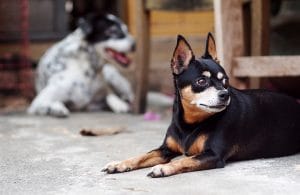Your garage is a vital part of your home, perhaps even more so during the winter months when it provides a refuge from the cold for your car, tools and supplies. But those very products that keep our cars and our homes running smoothly can also present a major danger to our pets.
Does your pet have access to the garage? Whether your pet can get there from inside the house or from the yard via a pet door, it’s important to make sure this space is a safe place for four-legged family members. Find out how to pet-proof your garage, below.
Identifying Car-Related Dangers
Your first step to making your garage pet friendly is to identify what’s not pet-friendly about your car paraphernalia.
“Antifreeze is one of the most common chemicals found in the garage that is incredibly dangerous to pets,” says Trupanion’s on-staff veterinarian, Dr. Denise Petryk, DVM, MBA. “Even the smallest amount can be fatal to both cats and dogs. Unlike many other chemicals found in the garage, such as rat poison or cleaning supplies whose strong fragrance often deter pets, antifreeze draws pets in with a sweet smell and taste.”
Remember: Not only is antifreeze a risk in and around containers that can possibly leak, but antifreeze can also leak from your car, puddling on the garage floor and causing a hazard. You can easily miss a spill if the car’s in place — but your pet can see and smell the tempting liquid.
“In small amounts, there might only be irritation to the mouth of a dog or a cat, but only a few teaspoons of undiluted antifreeze can be fatal,” says Petryk.
The car is also a major danger, even when parked, as a recently-parked car often has a warm engine, Petryk says. “This offers a tempting warm spot for pets to rest, where the danger of being caught in the engine or being run over is high.”
Make sure your cat hasn’t decided to take a nap under your vehicle by banging on the hood of your car before you get into it.
Identifying Other Dangers
Cars and chemicals may be the largest danger in your garage, but they’re far from the only ones. Garages are notoriously at risk for infestation by mice and rats, and many people put poison or mousetraps out to deter rodents, both of which present serious problems for pets.
“If you use spring traps, pets will try to lick the trap, especially if baited with something tasty like peanut butter,” says Debra M. Cohen of earthkind, a USA-based pest control developer, designer and bio-manufacturing company. “Traps can also get stuck on creatures they were unintended for. We once heard a story of a stick trap stuck on a dog’s ear … with a live-squealing mouse attached to the trap, too!”
Petryk points out one additional danger — the garage door itself, with its assortment of hinges, rollers and tension cables. It’s important to keep the garage door in top working order to prevent injury and to pet-proof the area to prevent access by jumping cats.
Creating a Pet-Friendly Location
With the dangers identified, it’s time to reorganize and create a pet-friendly garage. According to master-builder Karl Champley, a recently-conducted survey found that one-third of homeowners don’t even know what’s stored in their garage.
“The only way to really know what’s in your garage is to remove 100 percent of the items inside,” he says. “This forces you to make a storage decision on every item, and gives you the opportunity to wipe clean and inspect all surfaces for wear, tear, and potential hazards pets could encounter.” Champley recommends getting tools, boxes and chemicals off the garage floor.
John Cail of Petplan agrees, recommending shelving and storage bins as a way to get products up and out of an animal’s reach.
“Our garages are mostly for storage of items we don’t want in the house,” he says. “Often those things are hazardous and are best stored on sturdy, tall shelving. If we have cats in the home, we don’t want to leave room for them to crawl behind them either, so fitting everything tightly is best.”
He also recommends plastic storage bins that can be sealed as a way to keep products safely out of the way of curious pets as well as wall-mounted shelving.
“This ensures that bigger dogs can’t knock them down as easily, if they are feeling curious,” he says. “Cats, however, are unavoidably curious with a tendency to climb anything and need to be supervised more closely.”

Authors of 30+ travel guidebooks, Paris Permenter and John Bigley write about tips for dog-loving travelers.
Share:









